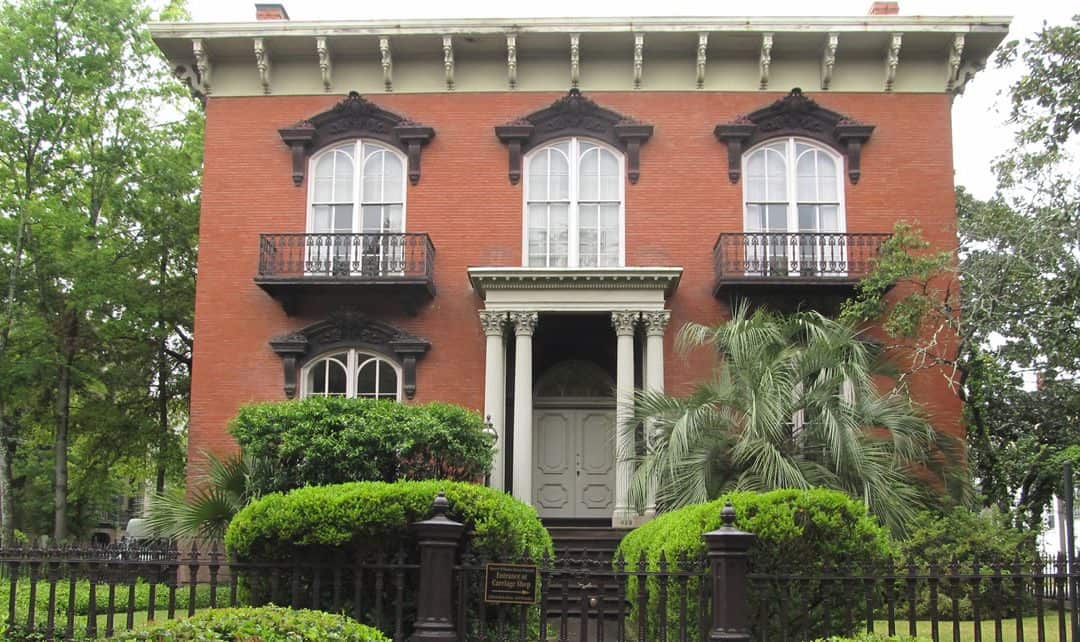The rose-coloured two-storey mansion, together with its sunken garden and large carriage house, takes up an entire city block. The Mercer Williams house, which sits across from leafy Monterey Square, is often touted as a must-see attraction while in Savannah, Georgia.
This was the home of art dealer and restorationist Jim Williams, the central character in John Berendt’s hugely popular 1994 book Midnight in the Garden of Good and Evil. On the New York Times best-seller list for more than 200 weeks, the book was later adapted for the screen and directed by Clint Eastwood, all of which helped boost tourism to the city.
Williams was one of Savannah’s earliest and most dedicated restorationists. He began restoring houses in 1955 at the age 24 and over the next 30 years restored more than 50 houses in Savannah and the Lowcountry.
But his “crown jewel” was the home at 429 Bull Street, in Savannah’s beautiful Historic District. The house had been vacant for about 10 years before he bought it in 1969 for $55,000. He then spent two years restoring the mansion that became his home. “I wanted this house the first time I saw it,” Williams is quoted as saying in the brochure promoting the house.
But his well-ordered life quickly turned upside down in the early morning hours of May 2, 1981, when Williams shot and killed his 21-year-old, part-time employee, Danny Hansford, inside his beloved mansion.
Claiming it was an act of self-defence, Williams sat through not one but four trials before eventually being acquitted. However, victory was short lived. Less than a year later, he died at the age of 59.

For sale in the carriage house gift shop are copies of the Bird Girl statue, which appears on the cover of the book Midnight in the Garden of Good and Evil.
The home is now owned by Williams’ sister Dorothy Kingery, who has opened it up to the public. The guided tour of the house glosses over the circumstances surrounding the murder and subsequent trials, focusing instead on Williams’ impressive art collection.
Two of his major interests were 18th and 19th century English and American portraits and Chinese export porcelain, both of which are well represented here. Other rooms contain Audubon engravings, ivory tusks and shells from Cabbage Island, the owner’s shark fishing retreat.
“That’s cookie,” says our guide Alex, as a black cat walks in through the front door. “He has the whole place to himself.”
When we arrive at the bust of King Edward VII near the mahogany stair rail carved by shipbuilders from Maine, we’re instructed to look up. The sight was a total surprise – a beautiful (and original) stained glass dome. How many homes have that?
Over the years, the mansion had welcomed many dignitaries and visitors from around the world including Margaret Thatcher, Jacquelyn Kennedy Onassis, Ladybird Johnson and Colin Powell.
On a side table in a front room, there are photographs of Williams in happier times, as well as photos of Clint Eastwood and Kevin Spacey taken during filming of the movie, which was shot partly in the house. The guide explained that, for the film, copies were made of all the artwork while the originals were temporarily put in storage.
The house was designed by New York architect John S. Norris for General Hugh W. Mercer, the great grandfather of Johnny Mercer (the singer/songwriter who penned Moon River and many other famous songs). Construction began in 1860 and was interrupted by the Civil War. When the war ended, General Mercer sold the unfinished structure to John R. Wilder, who completed it in 1868. Contrary to popular belief, no Mercer ever lived in the house that bears their name.
According to the brochure for the home, “Norris added Renaissance Revival elements to his standard mix of Greek and Italiante. The house and carriage house are constructed of deep rose coloured bricks called Philadelphia Reds, which were brought to Savannah aboard barges towed by sailing vessels.”
Using a symmetrical interior design, Norris combined 15-foot ceilings with floor-length windows and anchored the first floor plan with a 60-foot entrance hall that retains its original ceramic tile made in England at Stoke-on-Trent.
For many years, Williams operated his antique shop from the carriage house, which today serves as the gift shop selling original works by southern artists, and books on Savannah, including Berendt’s book.
Another familiar item here are copies of the memorable Bird Girl statue, which appears on the book’s cover. The original was located at Savannah’s historic Bonaventure Cemetery. The statue became such a popular stop for tourists that concerns for its safety and preservation prompted a move to the Telfair Museums’ Jepson Center for the Arts.
For visitors interested in learning more about Williams’ many home restorations, have a look at More Than Mercer House: Savannah’s Jim Williams and his Southern Houses, a book of essays written by Williams about his most important restorations including more than 27 pages of photos and illustrations on the Mercer House.
Diane Slawych is a contributing writer for REM.

















